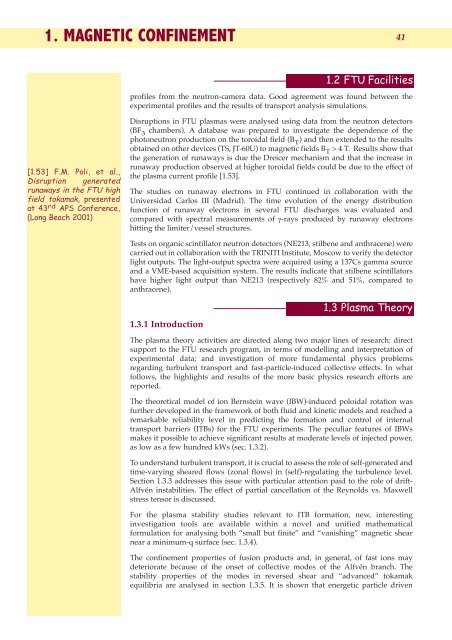1. magnetic confinement - ENEA - Fusione
1. magnetic confinement - ENEA - Fusione
1. magnetic confinement - ENEA - Fusione
Create successful ePaper yourself
Turn your PDF publications into a flip-book with our unique Google optimized e-Paper software.
<strong>1.</strong> MAGNETIC CONFINEMENT<br />
41<br />
<strong>1.</strong>2 FTU Facilities<br />
profiles from the neutron-camera data. Good agreement was found between the<br />
experimental profiles and the results of transport analysis simulations.<br />
[<strong>1.</strong>53] F.M. Poli, et al.,<br />
Disruption generated<br />
runaways in the FTU high<br />
field tokamak, presented<br />
at 43 rd APS Conference,<br />
(Long Beach 2001)<br />
Disruptions in FTU plasmas were analysed using data from the neutron detectors<br />
(BF 3 chambers). A database was prepared to investigate the dependence of the<br />
photoneutron production on the toroidal field (B T ) and then extended to the results<br />
obtained on other devices (TS, JT-60U) to <strong>magnetic</strong> fields B T > 4 T. Results show that<br />
the generation of runaways is due the Dreicer mechanism and that the increase in<br />
runaway production observed at higher toroidal fields could be due to the effect of<br />
the plasma current profile [<strong>1.</strong>53].<br />
The studies on runaway electrons in FTU continued in collaboration with the<br />
Universidad Carlos III (Madrid). The time evolution of the energy distribution<br />
function of runaway electrons in several FTU discharges was evaluated and<br />
compared with spectral measurements of γ-rays produced by runaway electrons<br />
hitting the limiter/vessel structures.<br />
Tests on organic scintillator neutron detectors (NE213, stilbene and anthracene) were<br />
carried out in collaboration with the TRINITI Institute, Moscow to verify the detector<br />
light outputs. The light-output spectra were acquired using a 137Cs gamma source<br />
and a VME-based acquisition system. The results indicate that stilbene scintillators<br />
have higher light output than NE213 (respectively 82% and 51%, compared to<br />
anthracene).<br />
<strong>1.</strong>3.1 Introduction<br />
<strong>1.</strong>3 Plasma Theory<br />
The plasma theory activities are directed along two major lines of research: direct<br />
support to the FTU research program, in terms of modelling and interpretation of<br />
experimental data; and investigation of more fundamental physics problems<br />
regarding turbulent transport and fast-particle-induced collective effects. In what<br />
follows, the highlights and results of the more basic physics research efforts are<br />
reported.<br />
The theoretical model of ion Bernstein wave (IBW)-induced poloidal rotation was<br />
further developed in the framework of both fluid and kinetic models and reached a<br />
remarkable reliability level in predicting the formation and control of internal<br />
transport barriers (ITBs) for the FTU experiments. The peculiar features of IBWs<br />
makes it possible to achieve significant results at moderate levels of injected power,<br />
as low as a few hundred kWs (sec. <strong>1.</strong>3.2).<br />
To understand turbulent transport, it is crucial to assess the role of self-generated and<br />
time-varying sheared flows (zonal flows) in (self)-regulating the turbulence level.<br />
Section <strong>1.</strong>3.3 addresses this issue with particular attention paid to the role of drift-<br />
Alfvén instabilities. The effect of partial cancellation of the Reynolds vs. Maxwell<br />
stress tensor is discussed.<br />
For the plasma stability studies relevant to ITB formation, new, interesting<br />
investigation tools are available within a novel and unified mathematical<br />
formulation for analysing both “small but finite” and “vanishing” <strong>magnetic</strong> shear<br />
near a minimum-q surface (sec. <strong>1.</strong>3.4).<br />
The <strong>confinement</strong> properties of fusion products and, in general, of fast ions may<br />
deteriorate because of the onset of collective modes of the Alfvén branch. The<br />
stability properties of the modes in reversed shear and “advanced” tokamak<br />
equilibria are analysed in section <strong>1.</strong>3.5. It is shown that energetic particle driven













